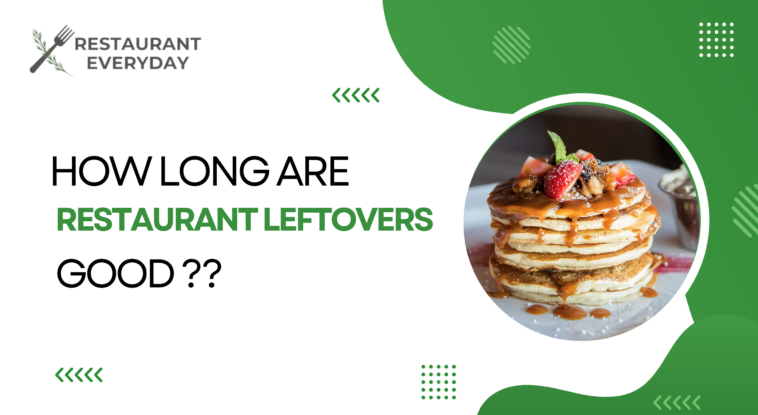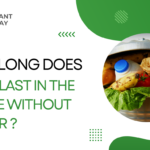The shelf life of restaurant leftovers depends on several factors, including the type of food, how it’s stored, and how quickly it’s refrigerated. Generally, it’s recommended to consume leftovers within 34 days to ensure they are safe to eat.
How long are restaurant leftovers good for
Introduction: how long are restaurant leftovers good for
Here are some guidelines for common types of leftovers:
1. Meat and Fish: These leftovers should be consumed within 34 days. If there’s a doubt about the freshness, it’s better to err on caution.
2. Dairy and Eggs: Leftover dairy-based dishes and eggs should also be eaten within 34 days.
3. Vegetables: Most cooked vegetables can be kept in the refrigerator for 34 days.
4. Rice and Pasta: Rice and pasta dishes can harbor Bacillus cereus bacteria that can cause food poisoning. It’s recommended to consume rice and pasta leftovers within 12 days and to reheat them thoroughly.
5. Soups and Stews: These can generally be kept for 34 days if stored properly.
Always store leftovers in airtight containers in the refrigerator at a temperature of 40°F (4°C) or below. If you’re unsure about the safety of a leftover dish, use your senses—smell, appearance, and texture—to assess its freshness. It’s best not to consume it if it looks or smells off.
It’s important to note that these are general guidelines, and the specific storage and shelf life can vary depending on the type of food and how it’s prepared. If you have any doubts about the safety of leftovers, it’s better to discard them to avoid the risk of foodborne illness.
Understanding food safety and leftovers
Understanding food safety and handling leftovers properly is crucial to prevent foodborne illnesses. Here are some fundamental principles and tips for ensuring the safety of leftovers:
1. Temperature Control:
Refrigerate promptly: Store leftovers in the refrigerator within two hours of cooking (or one hour if the temperature is above 90°F or 32°C).
Keep it cold: Set your refrigerator temperature at 40°F (4°C) or below to slow bacterial growth.
2. Storage Containers:
Use airtight containers: Seal leftovers in airtight containers to prevent cross-contamination and maintain freshness.
Divide into smaller portions: Large amounts of food take longer to cool down, increasing the risk of bacterial growth. Divide leftovers into smaller portions for quicker cooling.
3. Labeling:
Label containers with the date: Mark the date on leftovers to track how long they have been stored.
4. Reheating:
Heat thoroughly: When reheating leftovers, ensure they reach an internal temperature of 165°F (74°C) to kill any bacteria that may have developed.
Use a food thermometer: Check the temperature of the thickest part of the food to ensure it has reached the recommended temperature.
5. Time Limits:
Follow the 2-hour rule: Do not leave perishable foods (such as meat, poultry, seafood, eggs, and cooked leftovers) at room temperature for over two hours. In hot weather (above 90°F or 32°C), reduce this time to one hour.
6. Types of Leftovers:
Be cautious with certain foods: Some dishes, like rice and pasta, can harbor bacteria that produce toxins. Store and reheat them carefully.
7. Use Your Senses:
Smell and appearance: If leftovers have an off smell, unusual appearance, or unusual texture, it’s safer to discard them.
When in doubt, throw it out: If you’re uncertain about the safety of a leftover item, it’s better to err on the side of caution and discard it.
8. Educate Yourself:
Stay informed: Be aware of specific recommendations for different types of food. Certain foods may have other storage guidelines based on their characteristics.
Remember that these guidelines are general recommendations, and specific situations may vary. Always prioritize food safety, and if you have particular concerns or questions, consult relevant food safety authorities or professionals.
Guidelines for storing leftovers
Storing leftovers properly is crucial to maintaining their safety and quality. Here are some guidelines for storing leftovers:
1. Prompt Refrigeration:
Refrigerate leftovers within two hours of cooking. If the temperature is above 90°F (32°C), reduce this time to one hour.
Divide large portions into smaller ones to promote quicker cooling.
2. Temperature Control:
Set your refrigerator temperature at 40°F (4°C) or below to slow bacterial growth.
Use a refrigerator thermometer to ensure the temperature stays within the safe range.
3. Airtight Containers:
Store leftovers in airtight containers or wrap them tightly with plastic or aluminum foil.
This helps prevent cross-contamination and maintains the quality of the food.
4. Labeling:
Clearly label containers with the date when the leftovers were prepared. This helps you keep track of how long they’ve been stored.
5. Safe Storage Times:
Consume leftovers within 34 days to ensure freshness and safety.
Some leftovers, like soups and stews, may last up to 45 days, while others, like seafood or dairy-based dishes, should be consumed within 12 days.
6. Freezing:
If you don’t consume leftovers within the recommended time frame, consider freezing them.
Use freezersafe containers or freezer bags, and label them with the date.
7. Refrigerator Organization:
Place leftovers on the upper shelves of the refrigerator, where temperatures are more consistent.
Avoid overloading the refrigerator; proper air circulation is essential for maintaining a consistent temperature.
8. Avoid CrossContamination:
Store raw and cooked foods separately to prevent cross-contamination.
Keep raw meats on lower shelves to prevent juice from dripping onto cooked foods.
9. Reheating:
When reheating leftovers, ensure they reach an internal temperature of 165°F (74°C) to kill bacteria.
Use a microwave, oven, or stovetop for reheating, depending on the type of food.
10. Check for Spoilage:
Before consuming leftovers, check for any signs of spoilage, such as off smells, mold, or changes in color or texture.
When in doubt, discard the leftovers.
By following these guidelines, you can help ensure that your leftovers are safe to eat and maintain their quality. Always use your best judgment, and when in doubt, it’s safer to discard the leftovers rather than risk foodborne illness.
The shelf life of common restaurant leftovers
The shelf life of common restaurant leftovers can vary based on the type of food and how it’s stored. Here are general guidelines for the shelf life of some common restaurant leftovers:
1. Meat (cooked): Typically, cooked meat leftovers are safe to consume within 34 days when stored in the refrigerator. It’s essential to reheat them thoroughly before eating.
2. Chicken (cooked): Cooked chicken leftovers should also be consumed within 34 days when stored properly in the refrigerator. Ensure the chicken is reheated to an internal temperature of 165°F (74 °C).
3. Fish (cooked): Cooked fish leftovers are best consumed within 12 days. Fish can be more perishable than other meats, and its quality may decline more rapidly.
4. Pizza: Leftover pizza can be stored in the refrigerator for 34 days. You can reheat it in the oven or a toaster oven to maintain its crispiness.
5. Pasta (cooked): Cooked pasta leftovers can be refrigerated for 34 days. It’s essential to store them in an airtight container to prevent them from drying out.
6. Rice (cooked): Cooked rice can be stored in the refrigerator for 12 days. Due to the risk of Bacillus cereus bacteria, it’s crucial to cool and store rice quickly and reheat it thoroughly before eating.
7. Soup and Stews: Soups and stews can generally be stored in the refrigerator for 34 days. Reheat them thoroughly before consuming.
8. Dairy-based Dishes: Dishes containing dairy (such as cream-based sauces) should be consumed within 34 days. Ensure they are stored in airtight containers in the refrigerator.
Remember, these are general guidelines, and specific conditions can affect the shelf life of leftovers. Always use your best judgment and consider factors like the freshness of the original ingredients, the time it took to cool and store the leftovers, and any signs of spoilage. It’s safer to err on caution and discard the leftovers if in doubt.
Tips for reheating restaurant leftovers
Reheating restaurant leftovers properly ensures they are safe to eat and maintain quality. Here are some tips for reheating restaurant leftovers:
1. Use the Right Equipment:
Microwave: Convenient for quick reheating. Cover the food with a microwave-safe lid or plastic wrap to help retain Moisture.
Oven: Suitable for more oversized items or dishes that need to crisp up. Preheat the oven and use an oven-safe dish or baking sheet.
Stovetop: Ideal for soups, stews, and stir-fries. Reheat in a saucepan or skillet over medium heat.
2. Reheat to Safe Temperatures:
Ensure leftovers reach an internal temperature of 165°F (74°C) to kill bacteria. Use a food thermometer to check the temperature in the thickest part of the food.JJ
3. Reheat in Portions:
If you have many leftovers, consider reheating them in smaller portions. This helps ensure that the entire dish reaches the recommended temperature.
4. Add Moisture to Dry Foods:
For dry items like rice or pasta, add a little water, broth, or sauce before reheating to prevent them from becoming too dry.
5. Cover to Retain Moisture:
Covering the dish with a lid, microwave-safe plate, or microwave safe plastic wrap can help retain Moisture during reheating.
6. Stir or Rotate:
Stirring or rotating the food partway through the reheating process helps distribute heat evenly, ensuring that all dish parts are reheated.
7. Use a Steamer for Bread and Baked Goods:
Steaming is excellent for reheating bread, rolls, and baked goods. It helps maintain Moisture and prevents them from becoming too complicated.
8. Follow Restaurant Recommendations:
Some restaurants provide reheating instructions for their takeout items. Follow any specific recommendations they provide.
9. Avoid Reheating Certain Foods:
Some foods, like salads, may need to be more suitable for reheating. Be mindful of the type of dish and whether reheating is appropriate.
10. Check for Even Heating:
Before serving, check different parts of the reheated dish to ensure it has been heated uniformly.
11. Reheat Seafood with Care:
Seafood can be sensitive to overcooking. Reheat seafood just until it’s warmed through to avoid drying it out.
12. Consider the Original Cooking Method:
If the original dish was roasted, grilled, or baked, reheating in the oven may help restore its texture and flavor.
Always exercise caution when reheating leftovers, and when in doubt, follow the principle “if it’s not hot, it’s not done.” If you have specific instructions from the restaurant, follow them for the best results.
Signs that restaurant leftovers have gone bad
Recognizing the signs that restaurant leftovers have gone wrong is crucial to preventing foodborne illnesses. Here are some common signs that leftovers may have spoiled:
1. Unpleasant Odor:
If the leftovers have an off or unpleasant smell, it strongly indicates they may have spoiled. Trust your sense of smell; if it doesn’t seem right, it’s safer not to consume the food.
2. Mold Growth:
Visible mold on the food is a clear sign that it has spoiled. Discard any leftovers with mold, as some molds can produce harmful mycotoxins.
3. Changes in Color or Texture:
Look for any significant changes in the color or texture of the food. Spoiled leftovers may appear discolored, slimy, or have an unusual texture.
4. Sliminess or Stickiness:
If the leftovers feel slimy or excessively sticky, it’s a sign that bacteria may be present, and the food has likely gone bad.
5. Excessive Moisture:
Excessive Moisture inside the container can create an environment conducive to bacterial growth. Check for condensation or pooling of liquid, especially in sealed containers.
6. OffTaste:
If the flavor of the leftovers is off or tastes unusual, it’s a clear indication that the food may have spoiled.
7. Gas Production:
Be cautious if there is noticeable gas production in the container, as it could indicate the presence of harmful bacteria. This may cause the container to bulge.
8. Visible Signs of Decay:
Check for any signs of decay, such as wilted or discolored vegetables or changes in the appearance of fruits.
9. Packaging Damage:
If the packaging of the leftovers is damaged, compromised, or leaking, it could allow bacteria to enter, increasing the risk of spoilage.
10. Unusual Sounds:
While not a common sign, if you hear unusual sounds, such as fizzing or bubbling, it may indicate fermentation or bacterial activity when opening the container.
11. Expiration Date:
Check the expiration date on the original packaging or the use-by date provided by the restaurant. If the leftovers exceed this date, exercise caution.
When in doubt about the safety of restaurant leftovers, it’s better to err on the side of caution and discard them. Consuming spoiled food can lead to foodborne illnesses, and the symptoms may range from mild discomfort to severe health issues.
Best practices for minimizing restaurant food waste:
Reducing food waste is essential to benefit the environment and your wallet. Here are some best practices for minimizing food waste:
1. Plan Your Meals:
Plan your meals for the week before grocery shopping. This helps you buy only what you need and reduces the chances of food going unused.
2. Create a Shopping List:
Stick to a shopping list to avoid impulse purchases. Be mindful of expiration dates and buy in quantities you can realistically consume.
3. Understand Expiration Dates:
Familiarize yourself with date labels. “Sell by,” “use by,” and “best by” dates have different meanings. Understand that these dates are often about quality rather than safety.
4. First In, First Out (FIFO):
Practice the FIFO method when storing food. Use older items before newer ones to prevent older items from expiring unused.
5. Proper Storage:
Store fruits and vegetables properly to extend their freshness. Some items should be stored in the refrigerator, while others are best kept at room temperature.
6. Use Leftovers Creatively:
Get creative with leftover ingredients. Use them in new recipes, salads, or sandwiches to prevent them from going to waste.
7. Portion Control:
Serve smaller portions to avoid leftovers that might go uneaten. You can always go back for seconds if you’re still hungry.
8. Freeze Excess Food:
Freeze surplus perishable items, such as fruits, vegetables, and bread, before they spoil. This can extend their shelf life significantly.
9. Composting:
Start composting for food scraps and nonedible leftovers. Composting reduces landfill waste and produces nutrient-rich soil.
10. Donate Surplus Food:
If you have excess nonperishable items or unopened perishables that you won’t use, consider donating them to local food banks or shelters.
11. Be Mindful of Bulk Purchases:
While buying in bulk can save money, it’s essential to ensure that you can use large quantities before they expire.
12. Educate Yourself on Storage Techniques:
Learn the best storage techniques for different foods. For example, some fruits emit ethylene gas, which can speed up the ripening of nearby produce.
13. Preserve Foods:
Explore food preservation methods like canning, pickling, and drying to extend the shelf life of certain items.
14. Monitor Perishables:
Keep a close eye on perishable items in your refrigerator and use them before they spoil. Consider organizing your fridge to make items more visible.
15. Encourage “Clean Plate” Habits:
Teach and encourage family members or roommates to take only what they can finish to reduce plate waste.
By incorporating these practices into your routine, you can reduce food waste and positively impact both the environment and your budget.
Conclusion: how long are restaurant leftovers good for
In conclusion, the longevity of restaurant leftovers depends on various factors, including the type of food, storage conditions, and how promptly they are refrigerated. Generally, it is recommended to consume leftovers within 34 days to ensure safety and freshness.
Adhering to proper storage practices, such as using airtight containers, labeling with dates, and refrigerating promptly, is crucial in extending the shelf life of leftovers.
Additionally, reheating leftovers thoroughly to an internal temperature of 165°F (74°C) is essential to eliminate potential bacteria. It’s imperative to trust your senses when assessing the quality of leftovers; if there is any spoilage, such as an off smell, unusual appearance, or sliminess, it is advisable to err on the side of caution and discard the leftovers to prevent foodborne illnesses.
By understanding and implementing these guidelines, individuals can make informed choices about the safety and longevity of restaurant leftovers while contributing to the reduction of food waste.




